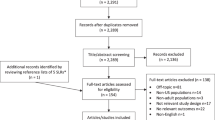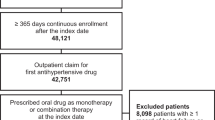Abstract
Variation in antihypertensive drug utilization and guideline preferences between six European countries (Denmark, Finland, Germany, Norway, Sweden, the Netherlands) was investigated. Our objectives were to compare between-country variability in utilization per class of antihypertensive agents and to assess guideline preferences in relation to actual use. Antihypertensive consumption data (2003) was retrieved. We classified antihypertensive agents using ATC-codes: C02CA – alpha-blockers (AB), C03A – thiazide diuretics (TD), C07AB – beta-blockers (BB), C08CA – dihydropyridine calcium antagonists (CA), C09A/C09BA/C09BB – ACE-inhibitors+combinations (AI) and C09C/C09D – angiotensin II receptor blockers+combinations (AT2). For each class, DDDs/1000 persons/day and share (%) of total antihypertensive utilization was calculated. Per class, relative standard deviations (RSD) across countries were computed. Current hypertension guidelines were requested from national medical associations. Total antihypertensive utilization varied considerably, ranging from 152.4 (Netherlands) to 246.9 (Germany) DDDs/1000 persons/day. RSD was highest for TD (106.2%) and AB (93.6%). Where guidelines advocated TDs (Norway and Netherlands), TD utilization was below (Norway) or just above (Netherlands) median TD use. Guidelines recommended TD (Norway and Netherlands), TD/BB/AI (Finland, German Physicians Association) or TD/BB/CA/AI/AT2 (Denmark, German Hypertension Society), Sweden had no recent national guideline. In conclusion, antihypertensive utilization patterns varied largely across these six countries, in absolute and relative terms. Furthermore, guidelines seem disconnected from clinical practice in some countries, and none of the guidelines discuss current utilization. Whether this reflects a need for change in prescribing or re-evaluation of guidelines warrants further research.
This is a preview of subscription content, access via your institution
Access options
Subscribe to this journal
Receive 12 digital issues and online access to articles
$119.00 per year
only $9.92 per issue
Buy this article
- Purchase on Springer Link
- Instant access to full article PDF
Prices may be subject to local taxes which are calculated during checkout



Similar content being viewed by others
References
World Health Organization. The atlas of heart disease and stroke 2004. http://www.who.int/cardiovascular_diseases/resources/atlas/en/(accessed 16 March 2006).
Moser M . World Health Organization – International Society of Hypertension guidelines for the management of hypertension – do these differ from the US recommendations? Which guidelines should the practicing physician follow? J Clin Hypertens 1999; 1: 48–54.
Psaty B, Siscovick D, Weiss N, Koepsell T, Rosendaal F, Lin D et al. Hypertension and outcomes research: from clinical trials to clinical epidemiology. Am J Hypertens 1996; 9: 178–183.
Baksaas I, Fugelli P, Halvorsen IK, Lunde PKM, Naess K . Prescription of hypotensives in general practice. Eur J Clin Pharmacol 1978; 14: 309–317.
Wolf-Maier K, Cooper RS, Banegas JR, Giampaoli S, Hense HW, Joffres M et al. Hypertension prevalence and blood pressure levels in 6 European countries, Canada, and the United States. JAMA 2003; 289: 2363–2369.
Tunstall-Pedoe H, Connaghan J, Woodward M, Tolonen H, Kuulasma K . Pattern of declining blood pressure across replicate population surveys of the WHO MONICA project, mid-1980 s to mid-1990 s, and the role of medication. BMJ 2006; 332: 629–635.
World Health Organization Collaborating Centre for Drug Statistics Methodology. The ATC/DDD system. http://www.whocc.no/atcddd(accessed 22 March 2006).
United Nations Economic Commission for Europe. UNECE Statistics. http://www.unece.org/stats/stats_h.htm(accessed 22 March 2006).
Organisation for Economic Cooperation and Development. Health at a glance – OECD Indicators 2005. OECD Publishing: Paris (France), 2005.
Begaud B, Bergman U, Eichler HG, Leufkens HG, Meier PJ . Drug reimbursement: indicators of inappropriate resource allocation. Br J Clin Pharmacol 2002; 54: 528–534.
Walma EP, Thomas S, Prins A, Grundmeyer HGLM, van der Laan JR, Wiersma TJ . NHG guideline hypertension, third revision (in Dutch). Huisarts Wet 2003; 46: 435–449.
Meland E, Ellekjær H, Gjelsvik B, Kimsås A, Holmen J, Hetlevik I . Pharmacological prevention of cardiovascular diseases in general practice (in Norwegian). Tidsskr Nor Lægeforen 2000; 120: 2643–2647.
Chobanian AV, Bakris GL, Black HR, Cushman WC, Green LA, Izzo Jr JL et al. Seventh report of the Joint National Committee on Prevention, Detection, Evaluation, and Treatment of High Blood Pressure. Hypertension 2003; 42: 1206–1252.
Abildgaard Jacobsen I, Bang LE, Borrild NJ, Feldt-Rasmussen BF, Hansen HS, Ibsen H et al. (eds). Arterial hypertension (in Danish). Danish Hypertension Society 1999. http://www.hypertension.suite.dk/klar999.pdf(accessed 22 March 2006).
Finnish Hypertension Association's Task Force. Treatment of hypertension (in Finnish). Duodecim 2002; 118: 110–126.
Lasek R, Müller-Oerlinghausen B, Berthold HK, Tiaden JD (eds). Recommendations for the therapy of arterial hypertension – second edition (in German). Drug Commission of the German Medical Association 2004. http://www.akdae.de/35/74_Hypertonie_2004_2Auflage.pdf(accessed 22 March 2006).
Guidelines subcommittee. 1999 World Health Organization – International Society of Hypertension guidelines for the management of hypertension. J Hypertens 1999; 17: 151–183.
Guidelines Committee. 2003 European Society of Hypertension – European Society of Cardiology guidelines for the management of arterial hypertension. J Hypertens 2003; 21: 1011–1053.
Bang LE, Bruun NE, Christensen K, Svendsen TL (eds). Arterial hypertension, treatment guideline (in Danish). Danish Hypertension Society – Danish Heart Association 2004. http://www.hypertension.suite.dk/kalender/arkiv/2004/2004(accessed 22 March 2006).
German Hypertension Society. Guideline for the prevention, recognition, diagnosis and therapy of arterial hypertension (in German). German Hypertension Society. 2003. http://www.uni-duesseldorf.de/AWMF/ll/046-001.htm(accessed 22 March 2006).
Anell A, Svarvar P . Pharmacoeconomics and clinical practice guidelines: a survey of attitudes in Swedish formulary committees. Pharmacoeconomics 2000; 17: 175–185.
Swedish Council on Technology Assessment in Health Care. Moderately elevated blood pressure – a systematic literature review (in Swedish – appendix in English). SBU; 2004. Report No.:170/1. http://www.sbu.se/www/subpage.asp?CatID=74&PageID=744(accessed 22 March 2006).
Psaty BM, Lumley T, Furberg CD, Schellenbaum G, Pahor M, Alderman MH et al. Health outcomes associated with various antihypertensive therapies used as first-line agents: a network meta-analysis. JAMA 2003; 289: 2534–2544.
Fretheim A, Oxman AD . International variation in prescribing antihypertensive drugs: Its extent and possible explanations. BMC Health Serv Res 2005; 5: 21.
Klungel OH, de Boer A, Paes AH, Seidell JC, Nagelkerke NJ, Bakker A . Undertreatment of hypertension in a population-based study in The Netherlands. J Hypertens 1998; 16: 1371–1378.
EUROASPIRE I and II Group. Clinical reality of coronary prevention guidelines: a comparison of EUROASPIRE I and II in nine countries. Lancet 2001; 357: 995–1001.
Sturm HB, Van Gilst WH, Swedberg K, Hobbs FDR, Haaijer-Ruskamp FM . Heart failure guidelines and prescribing in primary care across Europe. BMC Health Serv Res 2005; 5: 57.
Poluzzi E, Strahinja P, Vargiu A, Chiabrando G, Chiara Silvani M, Motola D et al. Initial treatment of hypertension and adherence tot therapy in general practice in Italy. Eur J Clin Pharmacol 2005; 61: 603–609.
Mantel-Teeuwisse AK, Klungel OH, Hofman A, Verschuren WM, Trienekens PH, Porsius AJ et al. Prescribing behaviour according to Dutch and European guidelines on the management of hypercholesterolaemia (1992–1999). Br J Clin Pharmacol 2006; 61: 592–600.
Gu Q, Paulose-Ram R, Dillon C, Burt V . Antihypertensive medication use among US adults with hypertension. Circulation 2006; 113: 213–221.
Author information
Authors and Affiliations
Corresponding authors
Rights and permissions
About this article
Cite this article
Stolk, P., Van Wijk, B., Leufkens, H. et al. Between-country variation in the utilization of antihypertensive agents: guidelines and clinical practice. J Hum Hypertens 20, 917–922 (2006). https://doi.org/10.1038/sj.jhh.1002089
Received:
Revised:
Accepted:
Published:
Issue Date:
DOI: https://doi.org/10.1038/sj.jhh.1002089
Keywords
This article is cited by
-
Change in antihypertensive drug prescribing after guideline implementation: a controlled before and after study
BMC Family Practice (2011)
-
Folgt auf die „Evidence-based Medicine“ eine „Confidence-based Medicine“?
Medizinische Klinik (2010)
-
No difference in between-country variability in use of newly approved orphan and non- orphan medicinal products - a pilot study
Orphanet Journal of Rare Diseases (2009)
-
Managing cardiovascular risk: the need for change
Journal of Human Hypertension (2008)
-
Hypertension in the elderly: a compelling contraindication for β-blockers?
Journal of Human Hypertension (2007)



